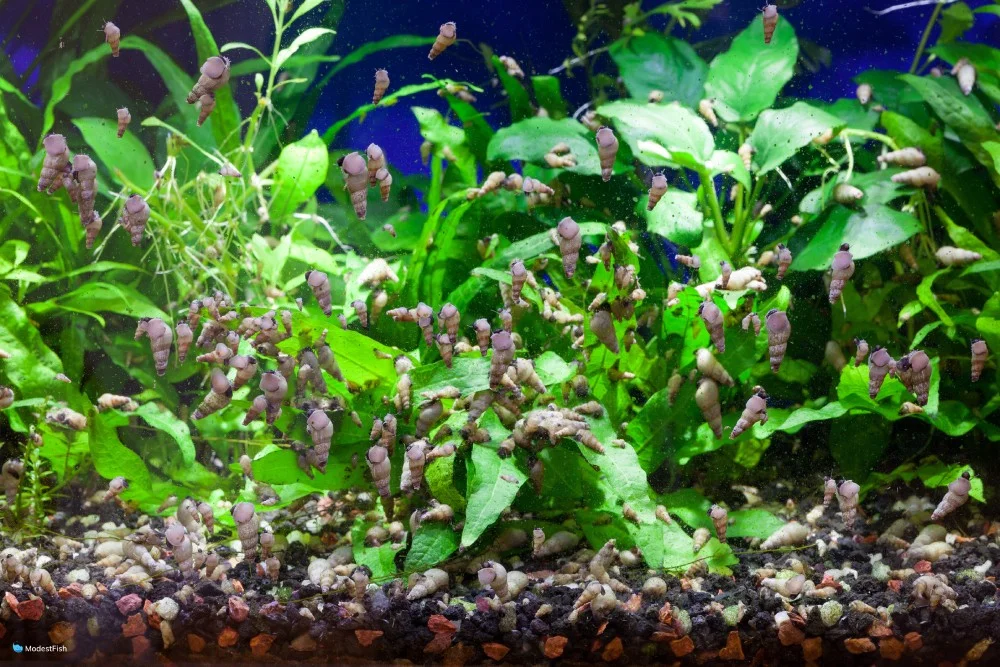What is Mulm or Detritus in Aquariums?
Is there a brown or black substance that appears to gather like dust bunnies across the floor of your fish tank? This dirt-like material is known by various names – such as mulm, detritus, and debris – and it’s a natural component of thriving aquariums. Let’s delve into what mulm consists of, whether its removal is necessary, and methods to reduce its presence.

What Is Mulm?
Mulm originates from a combination of fish waste, plant debris, uneaten fish food, and other organic matter decaying in the water. This organic material undergoes decomposition facilitated by bacteria, fungi, microorganisms, and tiny detritivores. Through their collective action, these organisms transform the organic matter into mulm, which contains nitrogen compounds and essential minerals that serve as nutrients for plants and algae. Interestingly, the fertile soil found in our yards and gardens shares similarities with mulm, consisting of decaying leaves, animal waste, and similar organic components. Therefore, mulm can be likened to the compost heap of an aquarium, where organic waste is converted into nutrient-rich compost capable of rejuvenating the substrate for plant growth.
is mulm harmful?
In general, detritus buildup is not a concern as long as your aquarium has sufficient biological filtration, such as beneficial bacteria and microorganisms, to effectively break down the waste. You can assess this by using an aquarium water test kit to ensure that levels of ammonia, nitrite, and nitrate are within safe ranges, ideally at 0 ppm ammonia, 0 ppm nitrite, and less than 40 ppm nitrate. However, if your tank is not properly cycled, a buildup of detritus could indicate that harmful levels of these nitrogen waste compounds are accumulating, posing a risk to your fish.
It’s important to note that mulm typically appears as brown or black sediment. If you notice substantial amounts of uneaten food or other organic matter that isn’t decomposing, it’s advisable to remove them using a gravel vacuum. This helps prevent potentially lethal spikes in nitrogen waste levels within the aquarium.
(Mulm is beneficial to planted aquariums because they revitalize the substrate and add nutrients for plants to consume. )
Mulm, though unsightly, indicates a healthy aquarium ecosystem capable of processing waste efficiently without compromising water quality. Similar to natural water bodies, its presence signifies a rich source of nutrients vital for sustaining plant and animal life. Some aquarists deliberately encourage mulm growth to create natural-looking habitats and provide cover for fish.
Should you get rid of mulm?
Whether mulm benefits your aquarium depends on the setup:
- Fish tanks without live plants: Excess mulm can cloud the water, particularly in tanks with bottom-dwelling fish. Removing it helps maintain water clarity and a cleaner appearance.
- Fish tanks with live plants: Mulm provides essential nutrients for plant growth and can reduce the need for additional fertilizers. However, excessive mulm may hinder light penetration or cover foreground plants. In such cases, partial removal may be necessary to ensure proper plant growth.
- Fish tanks with fry: Mulm in established tanks fosters microorganisms like infusoria, ideal as a first food for baby fish. Additionally, the debris offers shelter for smaller fry, promoting their safety and well-being.
(An aquarium siphon can be used to vacuum the bottom of a fish tank because the heavier substrate sinks to the bottom while the lighter mulm gets sucked up.)
How do you remove or hide mulm?
To remove mulm, consider the following methods:
- Aquarium Siphon: Use an aquarium siphon to vacuum up mulm, focusing on low-flow areas and spots behind decorations, driftwood, and rocks. Exercise caution if there are baby fish or shrimp present, opting for gentler methods like a turkey baster or airline tubing for debris removal.
- Increase Water Flow: Introduce power heads or circulation pumps to boost water flow in the tank. This helps disperse detritus into the water column, making it easier for the filter to capture and remove before returning clean water to the tank. Regularly clean the filter to prevent clogging and overflow.
- Substrate Selection: In planted aquariums where mulm is desired in the substrate, choose substrates with small, closely packed particles like sand, which camouflage the mulm and minimize its appearance. Alternatively, opt for substrates with small, pebble-sized particles and ample gaps between them, allowing mulm to sink and provide nutrients to plant roots without marring the tank’s aesthetics.
(Gravel-like substrate with a varied brown color is great at camouflaging and incorporating mulm particles.)
How to Get Rid of Hydra in Your Aquarium
If you’ve noticed tiny tentacle-like creatures in your freshwater aquarium, don’t panic – you may have encountered hydra. These fascinating freshwater organisms are relatively easy to manage. Let’s delve into what hydra are and explore some natural methods for removing them without harming your fish, plants, or beneficial bacteria.

What is hydra ?Top of Form
hese tiny, freshwater organisms of the genus Hydra are the distant relatives of jellyfish, corals, and sea anemones. Growing up to 0.4 inches (1 cm), they range in color from translucent white to green to light brown. Much like a sea anemone, hydra has a stalk or foot that attaches to surfaces (like plants, hardscape, or glass) and a mouth at the other end that is surrounded by long, wispy tentacles. These tentacles have stinging cells that are used to paralyze and catch their prey.
Scientists have long been interested in hydra because of their “immortal” cells and powerful regenerative abilities. If a hydra is split into pieces, each fragment regenerates to become a new, individual hydra. They can also reproduce asexually by producing buds or sexually by creating eggs.
(Green hydra (Hydra viridissima) has a unique, symbiotic relationship with photosynthetic Chlorella algae, which is responsible for its green pigment.)
Hydra can find their way into your fish tank through various means. They may lay dormant for months before experiencing a population boom, often triggered by heavy feeding of baby brine shrimp. These creatures might have hitchhiked on aquarium decorations, aquatic plants, rocks, or driftwood from an infected tank. Additionally, hydra can be introduced via live foods, plants, or hardscape collected from the wild.
In terms of danger to humans, hydra pose no threat. Their stinging cells are too weak to affect humans, and when disturbed, they retract their tentacles and form a protective ball to avoid predation.
As for their impact on aquariums, hydra primarily prey on microworms, insect larvae, and tiny crustaceans like cyclops, daphnia, scuds, and baby brine shrimp. While they are ambush hunters, they generally don’t significantly affect populations of adult fish and shrimp. Fry, being small, may be targeted, but their natural flight response often helps them evade hydra. Overall, hydra are considered a natural part of the aquarium ecosystem and typically do not cause major disruptions.
How to get rid of hydra
Manual removal of hydra is generally not recommended unless you have a very steady hand and a small population of hydra. Accidentally breaking off pieces of hydra during removal can lead to the growth of new hydra. Instead, consider decreasing the amount of food being introduced into the tank. When hydra are deprived of food, the majority will starve and eventually diminish in numbers. Target feeding fish or using feeding dishes for shrimp can help prevent food from spreading throughout the aquarium. Additionally, regular water changes and gravel vacuuming to remove excess food will aid in reducing the hydra population to unnoticeable levels.
Another natural method for removing hydra is to introduce predators that will consume them. Omnivorous or carnivorous fish that are small enough to notice hydra can be effective, such as guppies, mollies, betta fish, paradise fish, and gouramis. If the fish seem uninterested in consuming the hydra, try reducing feedings to stimulate their appetite.
(Aquariums with adult fish and snails rarely get large hydra populations because hydra is a convenient source of live food.)
Hydra are commonly found in fry grow-out tanks and shrimp-only aquariums where they are intentionally overfed with hydra-sized foods like baby brine shrimp or powdered fry food. Additionally, potential predators that could consume both fry and hydra are often removed from these setups. Fortunately, introducing snails such as ramshorn, pond, and spixi snails can help control hydra populations without posing a threat to baby fish and shrimp. Snails are adept at consuming hydra and also assist in cleaning up any excess food not consumed by the fry.
As a last resort, chemical treatments can be considered to eradicate hydra, but it’s crucial to conduct thorough research to ensure these methods do not harm other aquarium inhabitants. Before adding live plants and decor to your aquarium, you may also treat them to prevent hydra infestation, provided the treatment is safe for plants and aquatic animals. One effective option is Merck’s Safe-Guard liquid dewormer for goats, containing fenbendazole as the active ingredient. Shake the bottle vigorously before treating the aquarium with 1 drop of medication per gallon of water. This medication acts quickly, usually within 24 hours, and has proven safe for use with snails, shrimp, fish, plants, and beneficial bacteria. Following treatment, perform a 50% water change after three days, and redose the tank if necessary.
Easy Ways to Get Rid of Aquarium Pest Snails
Bladder, ramshorn, and Malaysian trumpet snails are commonly referred to as pest snails within the aquarium hobby due to their rapid reproduction rates and difficulty in removal once introduced to a fish tank. These snails can enter your aquarium by hitchhiking on live aquatic plants or even by hiding at the bottom of fish bags from the pet store.

Are pest snails bad for my fish tank?
Despite being labeled as “pest snails,” bladder, ramshorn, and Malaysian trumpet snails are highly beneficial in aquariums and play a crucial role in the aquatic ecosystem. They serve as natural cleaners by consuming algae, leftover fish food, and decomposing organic matter such as fish waste. Additionally, they contribute to the diet of snail-eating fish in your tank.
These snails are not harmful to live fish or plants; instead, they aid in maintaining a clean and balanced aquarium environment. They help in removing dead organisms and decaying plant matter, promoting overall cleanliness and health in the aquarium.
(Even though they are known as “pest snails,” ramshorn snails are often kept by fish keepers for their cleaning abilities and beautiful color variations.)
To manage aquarium snail populations effectively and prevent them from overrunning the tank, consider implementing one of these five proven methods:
- Manual Removal: Regularly inspect the tank and manually remove snails by hand. You can use a net or a dedicated snail trap to capture them efficiently.
- Natural Predators: Introduce fish species or invertebrates that feed on snails, such as loaches, puffers, assassin snails, or certain species of freshwater shrimp. These natural predators can help control snail populations.
- Reduce Feeding: Limit the amount of food provided to the aquarium to reduce excess nutrients that contribute to snail population growth. Be mindful not to overfeed, as leftover food can serve as a food source for snails.
- Chemical Treatments: Consider using snail-specific treatments or chemicals that are safe for fish and plants to eradicate snails. However, exercise caution and carefully follow instructions to avoid harming other tank inhabitants.
- Prevention: Take preventive measures to minimize the introduction of snails into the aquarium. Quarantine new plants and decor, and thoroughly inspect them for snails or eggs before adding them to the tank. Additionally, avoid overfeeding and maintain proper aquarium hygiene to discourage snail reproduction.
By implementing these methods, you can effectively manage and control snail populations in your aquarium while maintaining a balanced and healthy aquatic environment.


